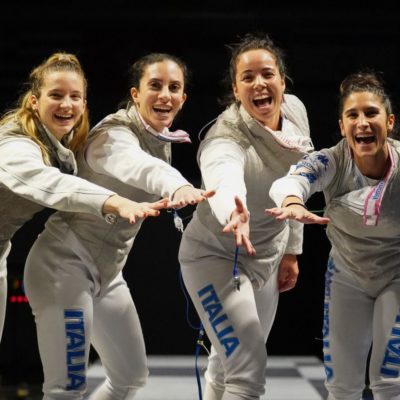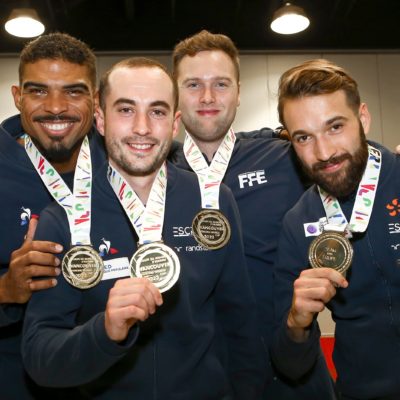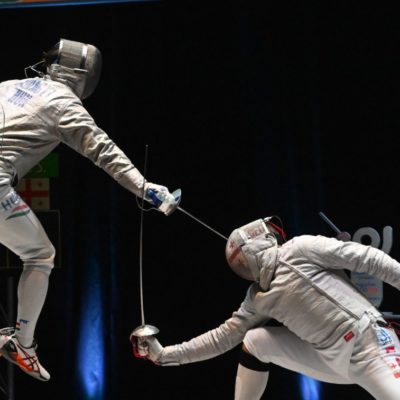I am sitting in the kitchen of “my” apartment at the ACG/USOC HPC, watching the skies lighten through a perpetual haze over the nearby mountains, with a rooster crowing in the background and owls, which seem to hoot constantly. And if it is not the owls, then it is the cicadas.
It is hard to believe how the days go by in a whir until one sits down late in the evening trying to figure out just what happened that day. There are so many little things to be consumed by, each one important in its own right and yet each one just time consuming enough that one doesn’t feel much was accomplished. We have all had that feeling and probably do most of our work week, but here at the Olympic Games and similarly at other major international tournaments, the tempo increases and the trivia become obstacles and the obstacles become mountains. Just the issue of traveling to different points – be it to where most of the athletes are (Olympic Village), to the training at the Village (Dekalia), to US training (12-15 minute walk from the ACG or half hour bus ride from the Village), to the competition venue (half hour from the Village or a total of an hour from the ACG if one doesn’t want to spend all one’s money on cabs), to picking up tickets for the athletes to give to family members, to finding inexpensive restaurants near the ACG for evening meal, and on it goes.) All these small challenges mount up to fill the day.
And just how fast is the clock ticking? Well, we are now within a day of the start of the fencing competitions at the 2004 Olympic Games. Everyone’s nerves are stretched taut and on Thursday, 12 August, the agony became more defined as the draw was completed for each of the individual tableaux. Captain Jeff Bukantz and staff liaison, Carla-Mae Richards, made the trek from the Olympic Village (Carla via ride from the ACG to the Village to catch the bus to the venue) for the technical meeting and the draw. The trip from the Village took about 35 minutes at a time we would consider “rush hour” back home and went very smoothly.
The Technical meeting was quite fascinating especially since they have added a new twist to weapons control. Since there have been enough complaints through the years and there is so much television involved for fencing this time, the SEMI Commission of the FIE has decided that each fencer in sabre and foil will have to appear at weapons control with lame to ensure proper fit of the lame. There will be a special mark on the lame to indicate that it meets size specification.
As this is the first time this type of inspection has been done it will be interesting to see just how well it will work. Since the information was just given out at the meeting and weapons control is not scheduled to be open on 13 August due to Opening Ceremonies chaos, it will have to wait until our sabre fencers get to the venue the morning of the 14th. The plan will be to have the other fencers come to weapons control a day or two before their competition to have the lame checked.
The draw was done in the finals area with representatives from each of the delegations seated in the stands and a big screen mounted on the finals strip showing the tableau and, through a computer, showing the position of each fencer in the tableau after the draw. For the draw each succeeding pair is randomly placed in order or opposite order depending on the draw; i.e. fencers seeded 1 and 2 may either be placed in the tableau as 1 and 2 or 2 and 1. At the World Championships the draw is done with the captain or chief of mission of each delegation present for the toss of a coin.
Here the FIE had four egg type shells that twisted open to reveal a “P” or an “I” letter embedded in the core of the shell. If a “P” was in the shell the pair of fencers reversed their positions (e.g., 2 then 1); if an “I”, then the fencers retained their seeded position. As you can imagine that has a marked impact for the fencers – who they will be fencing as they advance in the ladder. The egg type shells were in a bowl mixed each type by a volunteer from the organizing committee.
There were some tough draws for our fencers and they will be pitting the best of their skills within the first two bouts in the tableau; for the Jacobsons, assuming they win their first bouts, they will face each other in the round of 8. Though that ensures that the US will have a fencer in the medal round, it is a disappointment that they have to challenge each other for that honor. Or is it just the fickle finger of fate?? The two athletes are taking it all in stride and have had this circumstance arise in the past.
As for the other fencers each one knows their opponents from prior World Cup competitions so knows how to prepare mentally for the upcoming duel for the gold. This team is ready and the bouts can go either way with US fencers the advantage of extended training, preparation and experience. No matter the outcome they are winners to all of us, for their dedication and focus and setting new standards for those who follow in their footsteps.
Check out http://www.athens2004.com/en/resultsFencing/results; click on Men or Women in the left navigation bar, choose an event, and in the Available Information drop-down menu, choose Results Bracket.
Real-time results during the competition should be available there, as well.
Later in the day the USOC had a press conference for the team at the Main Press Center (MPC) and about half of the athletes went. The other half decided it was time to stay out of the limelight and just prepare for the upcoming battles. Those that went handled themselves very well and have become quite adept at fielding difficult questions from the media. That conference was the last of the media for this team until the competitions are done.
This has been an unusual problem for our sport – the high volume of media requests for American fencers. When someone talks about the sport’s “Plan For Success”, they should always include balancing media requests with athletes’ preparation for competition. That is a very delicate balance and one that is uppermost in the concerns of the USFA. Media attention is great for the sport but can create havoc with athletes’ preparation for high-level competition.
Suzie Paxton is the USOC media staff person for fencing and has spent full days juggling the requests and inquiries about this team. No one should envy her job as it is quite demanding to remain diplomatic, friendly and cooperative with the media while at the same time protecting the team from “overexposure”.
Tonight is Opening Ceremony and most of the athletes, except men’s sabre team, will be marching with the US Delegation so keep your eyes peeled for them. The rest of the team will be glued to the television, either at the Village or at the ACG.
The USOC tries to provide a pleasant setting for all those who do not march, most of whom have their competition within a couple of days of the ceremony. For those who do march, the evening is quite late and the length of time involved is enormous. The athletes, through their Olympic Committee, have to assemble by 4 pm, for a 7 pm start and then do not leave until quite late and then it takes some time to get back to the Village so it is likely that one returns in the early hours of the morning. But for the athletes it has a truly significant meaning and it is an occasion they tend to regret the rest of their lives if they don’t take part.
We live a life filled with symbols representing our successes and failures. Amazing isn’t it when you think about all the little things that you do remember and so many of the major experiences fade into the background??





